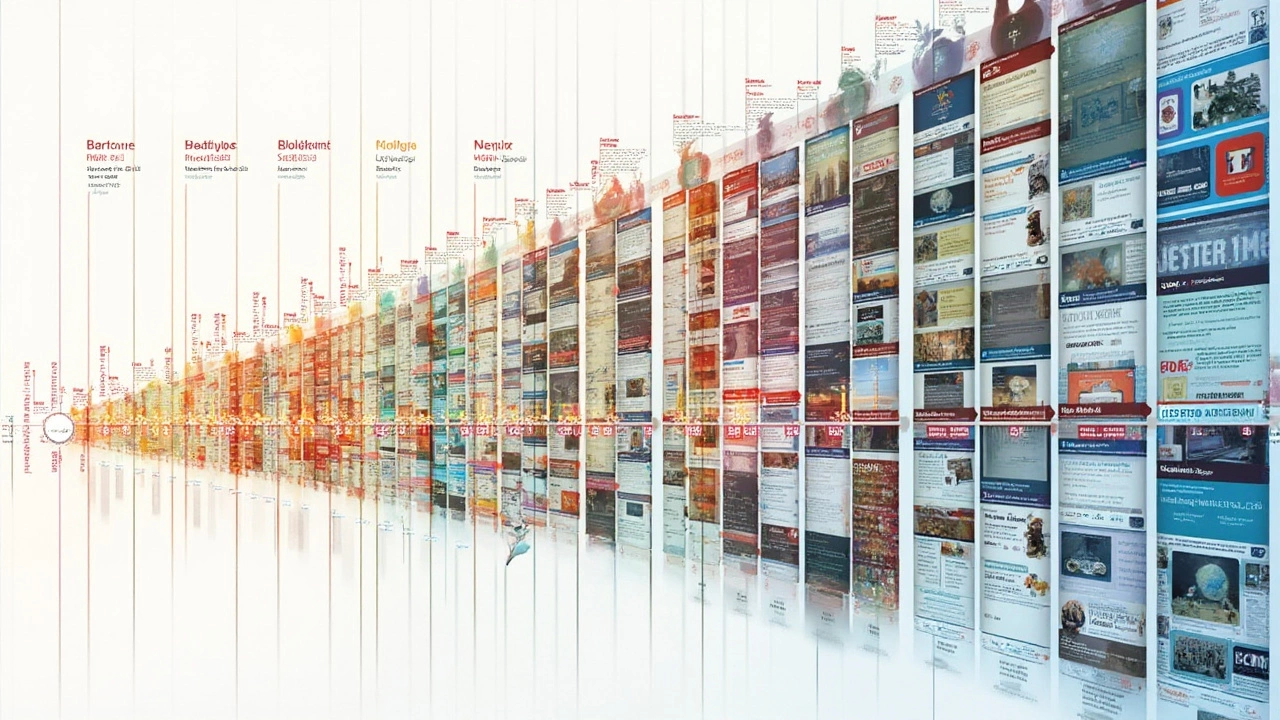
Exploring the Oldest Blogs: A Journey Through Digital History
The world of blogging has come a long way since its inception. Initially serving as personal journals on the internet, blogs evolved into powerful tools for information dissemination and self-expression. While the landscape is now dominated by influencers and digital marketing, some blogs have weathered the storm of change and continue to thrive.
Unearthing these seasoned blogs isn't just an exercise in nostalgia. These pioneers paved the way for the blogging platforms we use today. Their stories and continued relevance offer insights into how a simple concept transformed our digital experience. These oldest blogs are more than just archives; they are the chronicles of our internet's cultural evolution.
- A Brief History of Blogging
- Noteworthy Long-Running Blogs
- How Early Blogs Shaped the Internet
- Challenges of Maintaining a Long-Term Blog
- Lessons from the Oldest Blogs
- Tips for Creating a Timeless Blog
A Brief History of Blogging
Blogging, as we know it today, started in the late 1990s, a time when the internet was still in its early stages of user participation. The term "weblog" was first coined by Jorn Barger on December 17, 1997, to describe his process of "logging the web" as he surfed. It wasn’t until 1999 that this term was shortened to "blog" by a witty happenstance on Peter Merholz's site Peterme.com, changing "weblog" to the phrase "we blog". This playful interpretation soon caught on and became the foundation of the digital phenomenon.
Early blogs were incredibly diverse, catering to different passions and interests. Platforms such as Open Diary launched in 1998, providing a community space for writers to share their stories and connect with like-minded individuals. This was a precursor to the interactive nature of blogs today. As time went on, more user-friendly platforms like Blogger, founded by Pyra Labs in 1999 and later acquired by Google, revolutionized the ability for anyone with internet access to publish their thoughts online. Blogging became an accessible hobby rather than a technical challenge.
Sometimes referred to as the forefathers of digital expression, the first bloggers set the stage for what was to come by experimenting with different content styles and topics. Everything from personal diaries to political commentary found an audience. In the early 2000s, blogging tools further developed to include trackbacks and comments, enhancing interaction. By 2004, the concept of blogging had permeated mainstream culture so much that Merriam-Webster announced "blog" as its Word of the Year. The impact was profound, setting new standards and reshaping communication in the 21st century.
During this golden age, blogging laid the groundwork for what is now modern social media. It's fascinating to see how these oldest blogs—innovative for their time—remain archives of our digital past. Of the pioneering blogs, some like Boing Boing and Kottke.org continue their legacy today, proving the durability of the medium. A remarkable statistic from the early 2000s indicated that about 2.5% of internet users were already blogging, a figure that underscored the growing power of personal media. Leveraging this, platforms expanded features to include video and photo sharing, adding depth to storytelling.
“Blogs are whatever we make them. Defining 'blog' is a fool's errand.” - Michael Conniff, a digital media specialist, once mused this about the flexible nature of blogs. The early decades of blogging demonstrated how platforms adapted to and even spearheaded technological changes, cementing their place in the fabric of internet usage. Bloggers experimented with everything, from aesthetics, like the now-classic minimalist design, to monetization strategies, paving the way for influencer marketing.
As technology evolved, so did the utility of blogs. They catered to niche communities, turning enthusiasts into experts within their circles. As blogs transitioned from personal publishing tools to platforms with commercial potential, they set the stage for the rise of the influencer era. These pioneers of the blogging world demonstrated resilience and creativity, echoing the lasting impact that this form of digital communication possesses. By examining the evolution of these initiatives, it's clear that blogs helped transform the internet from a tool into a culture unto itself. The journey from "weblogs" to today's multimedia experiences continues to inspire future digital adaptations.
Noteworthy Long-Running Blogs
When you dive into the vast ocean of the internet’s history, you'll find many treasures, and among them are the oldest blogs that have stood the test of time. These blogs are like ancient scrolls of modern digital landscapes, chronicling the journey of the internet from a novel curiosity to an indispensable tool of daily life. Among them, few have defined the medium so prominently as Dave Winer's Scripting News. Launched in 1997, it is one of the longest continually running blogs, covering topics ranging from software development to internet culture and trends. Winer is often credited with helping drive the surge of blogging in the late 1990s and early 2000s, and his style combines personal anecdotes with professional insights.
The blog 'kottke.org', curated by Jason Kottke, also joins the ranks of longest running blogs. Launched in 1998, kottke.org is a web-centric collection of curiosities—an eclectic mix of links to interesting, quirky, and thoughtful pieces from across the web. Kottke has transformed his site into a full-time endeavor, a rare achievement in the ever-evolving world of blogging. His efforts show how passion and consistency can turn a personal project into a sustainable career, offering inspiration for up-and-coming internet writers.
Significant Contributions and Impact
'Boing Boing' deserves mention as it has evolved from a quirky print zine in 1988 to one of the internet’s most influential blogs by 2000. A collaboration by Mark Frauenfelder and others, its content ranges from cyberpunk and science fiction to political commentary. Not only has it maintained a devoted readership, but it has also influenced modern media culture by celebrating the counterculture.Another noteworthy example is 'Perez Hilton,' which started in 2004 and quickly established itself as the prototype for celebrity gossip blogs. Helmed by Mario Lavandeira, it broke stories in the entertainment world with a voice that was part irreverent and part snarky—a style many have tried to emulate since. Despite controversies and changes in the media landscape, it remains a staple in celebrity news.
"I always thought having a blog is like having your own TV channel, where people can tune in anytime they want," Jason Kottke once mused, reflecting on the freedom these platforms provide their creators.Today, these longest running blogs remain relevant not just because of their history but due to their adaptability and the unique voices they offer. They remind us of an era when individuals could shape digital discourse, offering intimate reflections even as the world around us digitized at an ever-increasing pace. As we look to these pioneering sites, their legacies offer a sense of continuity and an unyielding passion behind each post.

How Early Blogs Shaped the Internet
When the term "blog" first entered the internet lexicon, it heralded a new era of personal broadcasting. These oldest blog platforms were eclectic sites where tech enthusiasts, diarists, and aspiring writers penned their thoughts, sharing them with the world at large. In the mid-1990s, figures like Jorn Barger, who coined the term 'weblog,' started using this format to curate interesting links and commentary. His site, Robot Wisdom, became a prototype, inspiring others to curate, critique, and create. Early bloggers were akin to digital pioneers, often crafting their web pages manually before platforms like Blogger and WordPress emerged. This tinkering gave rise to a unique community of people emboldened to share their ideas without the gatekeepers of traditional media.
The landscape those early bloggers stepped into was fertile yet largely uncharted. The freedom to self-publish on such a grand scale was revolutionary, breaking down barriers that had long kept the voices of ordinary people in the shadows. The rise of these platforms democratized content creation, allowing individuals from diverse backgrounds to speak out and connect with others over shared interests. Unlike the polished articles we see today, these oldest blog entries were raw and authentic, capturing the zeitgeist of an era eager for change. It wasn't just about what people wrote; it was about the connections made. Discussions born out of these blogs often expanded into forums, email exchanges, and burgeoning social networks, bridging geographical and cultural divides.
One of the most significant impacts early bloggers had was in influencing public opinion. When Slashdot, a site founded by Rob Malda, began compiling news mainly concerning technology and science, it provided an edge that mainstream media couldn't replicate. Nicknamed "News for Nerds," the site was a precursor to today's tech journalism, often affecting how major news outlets perceived technology. As the internet began to swell with information, these oldest blog sites became trusted, niche sources, providing perspectives that could be found nowhere else. These platforms were more agile than traditional media outlets, frequently scooping stories on major tech developments and contributing to the open-source software's spread. The shift meant that anyone with a knack for understanding such topics could impact the industry in real-time.
The effect of early blogs transcended just tech and personal storytelling. They laid the groundwork for all content as we know it today, including the emergence of influencer culture and the sprawling apparatus of digital marketing. Fashion bloggers, political bloggers, and even food bloggers sprang up, carving out niches that catered to every interest imaginable. A distinct, user-driven form of journalism and storytelling was born. Where traditional media might fail to cover niche topics adequately, these early influencers filled the gap, offering highly tailored content that spoke directly to specific interests and communities. The rise of digital history owes much to these individual pioneers who wove complex narratives and niche reports that tracked how different sectors evolved.
In examining the digital history reshaped by early blogs, it is crucial to recognize that their influence continues today in subtler, albeit no less significant, ways. Blogs pioneered permanent archiving of thoughts and ideas, a shift which social media would later adapt to fit its own format. The systems of tagging, categorizing, and even hashtagging can trace their origins back to the need bloggers felt to organize and disseminate their voluminous content. Changes in how we consume media or even shop online find their roots in these revolutionary platforms. The disruption continues as modern content creators pull inspiration from the methods pioneered during this formative period. These were the blueprints for a connected digital era that valued the voice of the individual and sought a communal narrative.
"The early blogs were the internet's town criers, ringing the bell for this new digital world," noted an internet historian in a recent interview.Indeed, early blogs set a precedent for how dynamic and interactive online engagement could be. They nurtured an environment where people not only consumed content but also actively participated in its creation, critique, and propagation. This interactivity implies that blogs were an early form of social media, encouraging people to interact, argue, admire, or merely consume in concert with others. The evolution sparked by early blogging is a testament to the power of personal expression and the indomitable human urge to create and consume stories, a fundamental shift that still reverberates in the clicks and scrolls of today's internet users.
Challenges of Maintaining a Long-Term Blog
Keeping a blog going for years, or even decades, is not a simple task. Many bloggers start with high hopes, filled with enthusiasm for sharing their thoughts or expertise with the world. But as time goes on, they often encounter hurdles that test their perseverance. One of the biggest challenges is simply maintaining the creative spark. Inspiration doesn’t always come easily, especially when life gets busy or interests change. For long-running blogs, staying relevant is crucial. The internet landscape changes rapidly, and what was once trendy might become obsolete, necessitating constant adaptation and learning of new media strategies.
Another significant challenge is the technical upkeep. Technology progresses, and platforms evolve. Bloggers must keep their sites updated to remain functional and user-friendly. This involves not just aesthetic updates, but also ensuring compatibility with new web standards and maintaining site security amidst increasing malware threats. Moreover, blogs built on older platforms may even risk being phased out, requiring migration to newer platforms which can be a complex and time-consuming process.
Consistency in posting is another massive hurdle. Readers appreciate regular updates, and maintaining a posting schedule is critical for retaining an audience. But life can be unpredictable, and personal or professional commitments often take precedence. Many long-term bloggers mention the difficulty of balancing their blog with other responsibilities. According to a report by HubSpot, blogs that post regularly see more traffic and engagement than those that post sporadically. Yet, sustaining this consistency while avoiding burnout can be extremely challenging.
Financially, the sustainability of a blog can also be daunting. Monetizing a blog is no easy feat, particularly in a saturated market. Ad revenues fluctuate, and depending solely on them without diversification can be risky. Some bloggers turn to merchandise, sponsored content, or subscription models, each presenting its own set of challenges and requiring strategic planning to execute successfully. In essence, balancing the financial aspect while maintaining content authenticity is a delicate act.
Then there is the issue of maintaining authenticity. Long-running blogs have established their voice and brand, which their audience has grown to love and expect. Yet, as trends change and new topics arise, bloggers might face the temptation to veer away from their original style, potentially alienating their core readers. Remaining true to their roots while still evolving requires finding a harmonious balance in the content they produce.
"The real challenge isn't being heard when you're breaking news; it's being heard when you're telling an old story," noted The Atlantic in a recent article discussing digital media.
Lastly, there’s the emotional and mental aspect. Bloggers often put their heart and soul into their writing, and negative feedback or trolls can take an emotional toll. Building a thick skin is essential, but not always easy. The pressure to constantly deliver high-quality, engaging content can lead to stress and creative exhaustion. Nevertheless, for those who overcome these challenges, the reward of creating a digital legacy that informs, entertains, and inspires can be incredibly fulfilling.

Lessons from the Oldest Blogs
One of the most fascinating aspects of exploring the oldest blogs is discovering the secrets to their longstanding success. These digital diaries stand as time capsules in the fast-paced evolution of the internet. There are key lessons to glean from their journey, many of which remain relevant in the digital age dominated by social media and rapid news cycles. First and foremost is the power of authenticity. Bloggers who resonated then and continue to do so now did not chase trends. Instead, they focused on their unique voice and perspective, which attracted a loyal audience. This suggests that in a world overflowing with information, sticking true to one's voice is more impactful than trying to echo the masses.
Secondly, these blogs often focus on niche topics that may not necessarily grab mainstream attention but cater to devoted audiences. This approach is exemplified by sites like "Boing Boing," which started in the 1990s. Its founders curated engaging content around quirky and interesting topics that were originally overlooked by conventional media. This dedication to niche content shows that the internet is vast and diverse; as such, fostering a community around shared interests can result in a thriving blog, even over decades.
Sustainability is another key lesson. Early trailblazers understood the necessity of balance between personal life and digital pursuits. They created content that was manageable, avoiding burnout. This is invaluable advice for bloggers today who might feel pressured to endlessly churn out content due to the demand for freshness and novelty. Understanding personal limits and pacing to ensure quality over quantity can prevent the disparate throwaway culture prevalent in current digital narratives.
"Longevity in blogging is less about rapid growth and more about persistent quality over time."
Staying technologically adaptable also played a crucial role. Being among the first to leverage new tools and platforms helped these blogging pioneers remain in the digital conversation. Keeping abreast with changes, from SEO strategies to social media, ensured continued relevance without losing sight of their original vision. Blogs like "Kottke.org" evolved with the web while maintaining their essence, illustrating adaptability in a constantly evolving digital landscape. Bloggers should not only appreciate the past methodologies but also incorporate modern advances to stay ahead.
The enduring success of the longest-running blogs offers a roadmap for new bloggers. Understanding what gave these pioneers their edge and how they handled hurdles helps budding bloggers craft content that aims to last. Focusing on authenticity, valued niche, sustainable practices, and technological agility provides a virtual toolkit for embracing longevity in digital content creation. In a nutshell, while platforms and trends shift continually, these foundational principles remain as relevant as ever.
Tips for Creating a Timeless Blog
Creating a timeless blog starts with understanding what resonates deeply with your audience, irrespective of fleeting trends. Your blog should become a repository of value, offering wisdom that is as relevant today as it will be in the future. Start by focusing on universal topics within your niche that remain pertinent over time. Whether it’s advice for budding entrepreneurs, tips on sustainability, or evergreen travel experiences, these subjects draw repeat readers and offer enduring appeal. As the blogging world is constantly evolving, don't just chase the latest fads. Instead, ground each post in honest reflections and thorough research that appeal to human nature. By doing this, your blog stays not just a part of the digital space, but a go-to resource over time.
One should also prioritize consistency in voice and quality. A personal writing style that shines with character connects with readers on an emotional level, making the content memorable. Your unique perspective is a strength, especially in a sea of repetitive content. But, remember that quality trumps quantity every time. Take the time to craft well-researched and thought-provoking posts that can withstand the changing winds of the digital world. Making use of multimedia such as videos, podcasts, and imagery can also enrich your storytelling, adding layers that engage users on multiple sensory levels. Always ensure your content is accessible, too, incorporating clear language and straightforward design, which is essential for a long-lasting impact.
It’s crucial to engage actively with your community of readers. Interaction breeds loyalty, turning casual readers into lifelong fans. Respond to comments, ask for feedback, and perhaps even involve your audience in the creative process by letting them suggest topics or vote on future content ideas. Social media also plays a significant role here. By sharing your blog posts and engaging with users on these platforms, your blog acquires a wider reach. This not only helps in creating content that is responsive to your readers’ needs but also establishes a dynamic conversation that can inspire new blog ideas and foster a sense of community.
Above all, remember the strength of collaboration and learning from others. Reach out to fellow bloggers, attend digital workshops, and read other oldest blog examples such as 'Boing Boing' or 'Kottke.org'. By exchanging ideas and techniques, you expand your own understanding and capability. Networking with influential bloggers can also bring in diverse insights and possibly, guest contributions that add rich variety to your blog's offering. As Tim Berners-Lee, founder of the World Wide Web famously said,
“The web is more a social creation than a technical one. It is a tool for communication… that brings people together.”True collaboration can drive your blog from fleeting to timeless.
To quantify the importance of adapting to your audience, consider a simple table illustrating content longevity against audience engagement:
| Content Type | Longevity | Engagement Rate |
|---|---|---|
| Evergreen Posts | High | Very High |
| Trendy Topics | Low | Moderate |
| Seasonal Posts | Medium | Variable |
In the digital age, nothing stands still. By imbibing the spirit of innovation and creativity, while holding steadfast to authenticity, your blog can not only survive the test of time but also remain a celebrated part of the digital history.





Written by Arjun Mitra
I am an IT consultant with a keen interest in writing about the evolution of websites and blogs in India. My focus is on how digital spaces are reshaping content creation and consumption. I aim to provide insights and strategies for those looking to thrive in the digital landscape.
All posts: Arjun Mitra